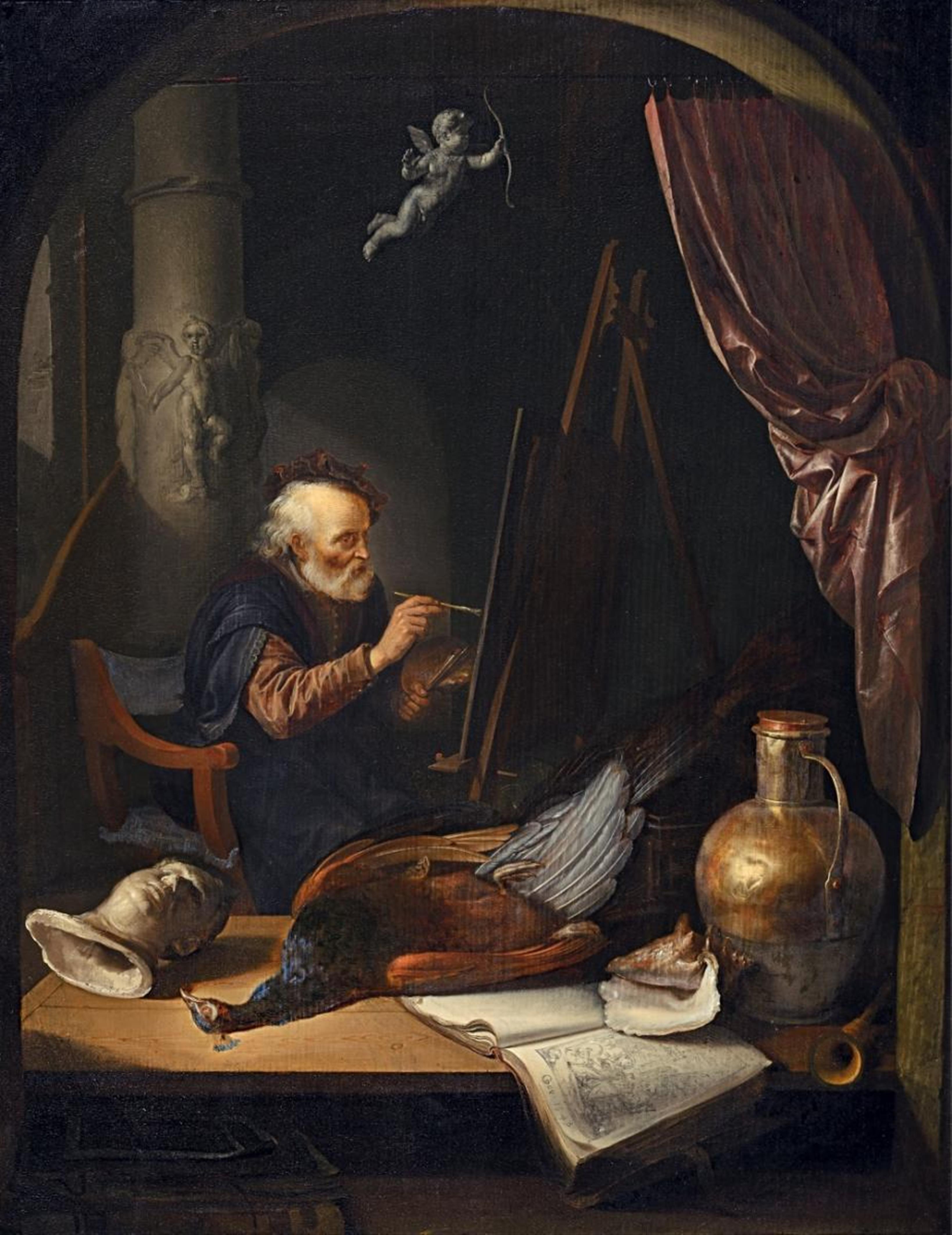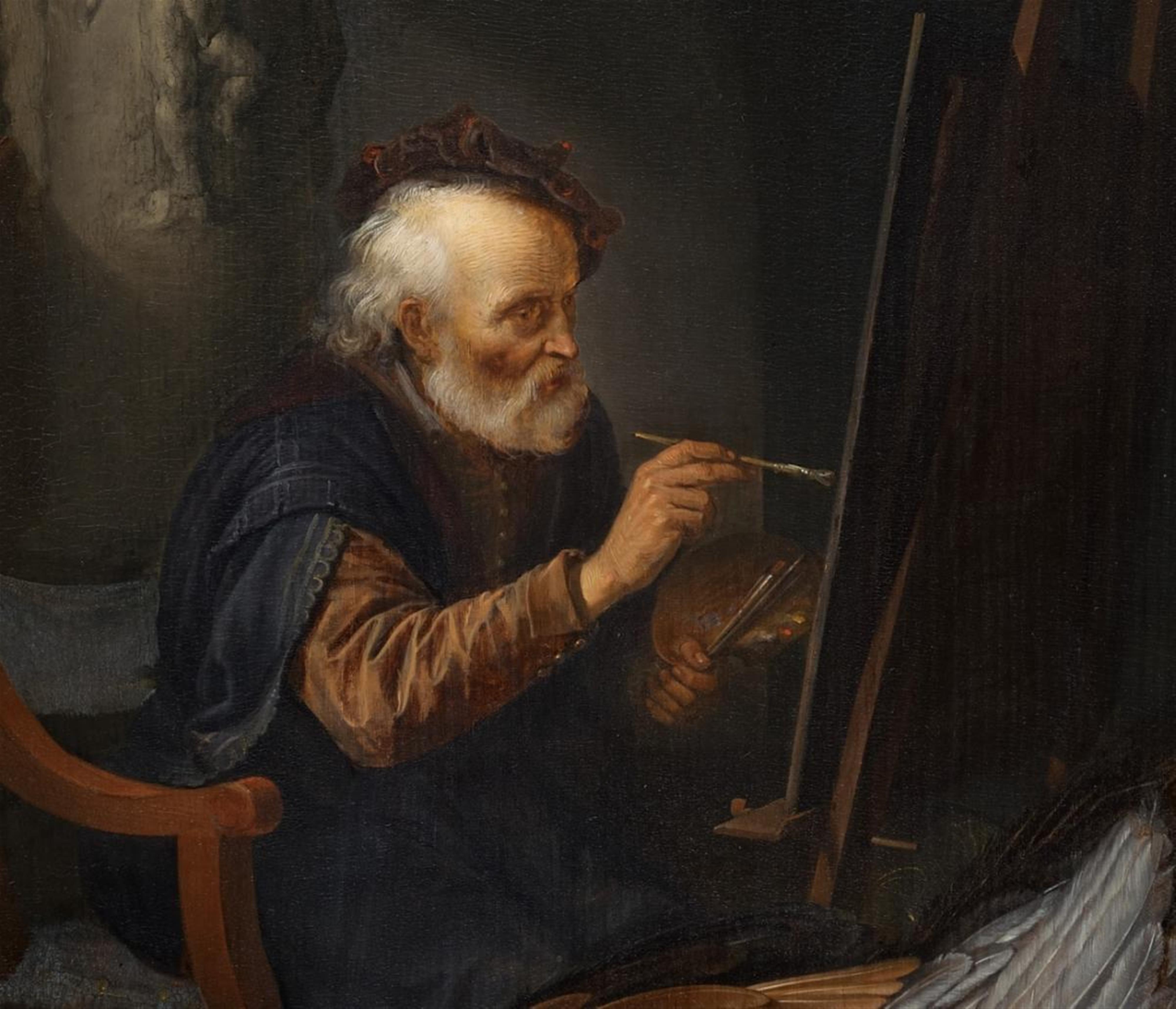Gerrit Dou
Painter in his Studio
Oil on panel. 68.2 x 53.5 cm.
GDov 1649 (on the book).
Gerrit Dou was 36 years old when he produced the painting 'Painter in his Studio' in 1649. It shows and old man lost in concentration on his work. He is elegantly dressed in a grey cloak over a brown jacket, such as the scholars used to wear, together with a beret of red-brown velvet. Because of the position of the easel and canvas we are unable to see what the man is painting. It could be the objects laid out on the table in the foreground, but these are directed at the viewer and therefore wouldn't be seen in the same way by the painter.
The scene is set in a tall room, lit by a window on the left hand side. The falling light accentuates the head of the painter, which is reflected in the shiny surface of a bronze tankard, and a copper-coloured, gathered curtain on the right. If the curtains were drawn, the scene would hidden, therefore giving the feeling of an excerpt on a theatre stage.
The painting is, in many ways, an unusual work by Gerrit Dou. Measuring 68 x 53 cm it belongs to the very few 'large' pictures from his hand. The composition on the other hand is less detailed than his other works. Where these are mostly very colourful, this work offers a finely graduated, particularly subtle colour palette built from various tones of brown, grey, gold and copper with white and dark blue lending contrast.
The key difference to the great part of Dou's paintings lies in the fact that it is not a genre picture, and also not a self-portrait - of which Dou had produced many.
Eric Sluitjer and Ronni Baur have studied the iconography of this picture and have established that it depicts an allegory to the art of painting. In a self-referential way, Dou is displaying his interpretation of painting. At the age of 15 he entered Rembrandt's workshop and worked in close proximity to him up until he left for Amsterdam in 1631. He lived his whole life in the same house in Leiden, and despite great success, he lived simply and never married. His life consisted only of painting, at which he worked with great diligence, patience and devotion. The same could also be said for the painter in this picture. The emergence of a work of the art of painting also begins with inspiration, represented here by the flying Putto, shooting his arrow. His job is the 'imitatio', the imitation of nature, for which the objects laid out in the forground stand. The great painter must also study art and poetry himself, here reflected in the arrangement of the plaster busts, the open books and the musical instruments.
Sluijter noted that Gerrit Dou deliberately chose the peacock here to demonstrate the competition between 'natura' and 'pictura', between nature and painting. Here it may also be read that in the representation of nature we are overcoming its transience. Whilst the colourful feathers of the peacock are preserved or frozen in painting, something which nature is incapable of doing, the peacock itself has already been subjected to its temporary fate.
It is also interesting to note that this animal, dominantly placed in the forground, has been a symbol of vanity since the Antiquity. According to Dou, vanity damages the painter, whereas patience should be one of its principles. This is represented by the illustration in the open book which shows the biblical characters of Tobit and Anna: patiently waiting for his son, Tobit tends to the fire whilst Anna has the endless task of spinning wool.
At the time this work was painted, described by Ronni Baer as 'one of his most beautiful', Dou was of those painters, famous in all Europe, whose works were particularly in demand and expensive. He was said to be the founder of the so-called 'Leidener fine painters'. At the age of 28 his patron, the historian and Mayor of Leiden, Jan Orler, named him as a painter whose style should be imitated by all young painters. In fact, many artists of the following generations absorbed his precise painting style and his appealing 'window pictures' together with his typical representation of single motifs.
Provenance
Kurfürstliche Galerie, Munich. - Alte Pinakothek, Munich. - With art dealer Hoogendyk, Amsterdam. - A. Jurgens Collection, London. - Christie´s, London, 12.3.1948, lot 136. - D.M.K. Marendaz, London, 1948. - His sale, Sotheby´s, London, 11.7.1973. - Galerie St. Lukas, Vienna. - Private collection, Germany.
Literature
C. Hofstede de Groot: Beschreibendes und kritisches Verzeichnis der Werke der hervorragendsten holländischen Maler des XVII. Jahrhunderts, 1907, vol. I, p. 437, no. 317. - W. Martin: Gerard Dou. Des Meisters Gemälde, Stuttgart-Berlin 1913, p. 58. - R. Hunnewell: Gerrit Dou´s Selfportraits and Depictions of the artist, Doctoral Thesis, Boston University 1983, p. 189-193. - C. Brown: Images of a golden Past, New York 1984, p. 215. - R. Baer: The paintings of Gerrit Dou, Dissertation New York University 1990, no. 50. - Eric Sluijter: De lof der Schilderkunst, Hilversum 1993f, p. 23, ill. 6. - Stephanie Sonntag: Ein Schauspiel der Malkunst, Munich/Berlin 2006, p. 85 and 301.
Exhibitions
London 1980.




